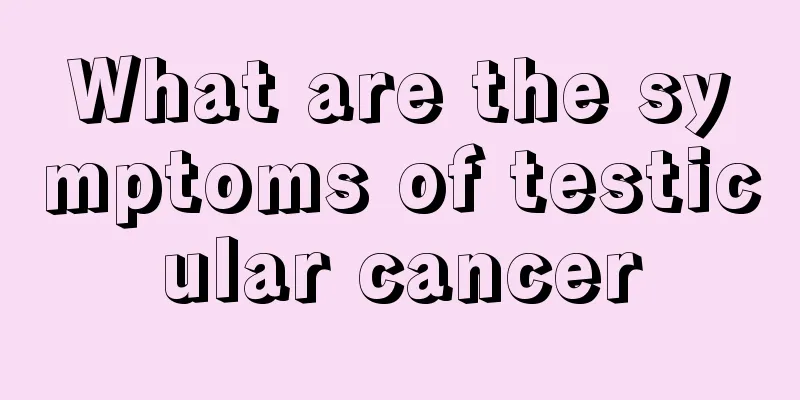What are the symptoms of testicular cancer

|
What are the symptoms of testicular cancer? If your testicles are uncomfortable, you will naturally think of this problem, especially now that various cancers are frequent and high, so that everyone is afraid of cancer. Therefore, early detection and early treatment are very important principles. Testicular cancer is a malignant tumor exclusive to men. Next, let's talk about the symptoms of testicular cancer. Physical examination can palpate the enlarged, tough, heavy testicle on the affected side, and the transillumination test is negative. Testicular tumor markers, human chorionic gonadotropin (HCG) and alpha-fetoprotein (AFP) concentrations may be increased in the serum of patients with seminoma, choriocarcinoma, embryonal carcinoma or mixed germ cell tumor, respectively. B-ultrasound shows that the testicles are uniformly enlarged, the echo is enhanced but uneven, and the blood flow signal is strong. CT examination mainly observes the metastasis of retroperitoneal lymph nodes. Testicular tumor is one of the common tumors in urology. It is almost always malignant, and there are three peaks in the age of onset: yolk sac tumor (infantile embryonal tumor) is the most common in infancy; various types of testicular tumors can be seen between the ages of 20 and 40, but seminoma is still the most common, and seminoma is the main tumor after the age of 70. Its cause is still unclear, and it is currently believed that its onset is related to both genetic and acquired factors. Among them, it is most closely related to cryptorchidism. The chance of cryptorchidism developing tumors is 10 to 14 times greater than that of normal people. Cryptorchidism in the abdominal cavity is higher than that in the groin. Testicular fixation does not reduce the incidence of malignant changes, but it can make tumors easier to detect. The most common symptom is a gradual, painless enlargement of the testicles with a feeling of heaviness. The enlarged testicles of seminoma often maintain the testicular contour and have a consistent texture, while teratoma is nodular and has inconsistent hardness and softness. About 10% of patients feel pain due to intratesticular bleeding or infarction, and 10% of patients may have metastatic symptoms, such as large retroperitoneal lymph node metastasis, compression of nerve roots, back pain, lung metastasis may cause cough and dyspnea, duodenal metastasis may cause anorexia, nausea and vomiting, bone metastasis may cause bone pain, etc. Testicular Leydig cell tumor should be considered when children have testicular masses and symptoms of precocious puberty, or adults have gynecomastia and loss of libido. The cause of testicular cancer is still unknown, and it is currently believed that its onset is related to both genetic and acquired factors. Among them, cryptorchidism is the most closely related. The chance of developing tumors in cryptorchidism is 10 to 14 times greater than that in normal people, and cryptorchidism in the abdominal cavity is more likely than in the groin. |
<<: What are the common symptoms of testicular cancer
>>: Introducing the symptoms of testicular cancer
Recommend
Is bile duct cancer caused by hepatitis B?
There is a certain correlation between bile duct ...
How to treat acquired curly hair
There are many reasons for acquired curly hair. F...
What is the cause of excessive sputum in breast cancer
Excessive sputum in breast cancer may be caused b...
What causes sweaty legs? What causes sweating?
It is normal to sweat in the hot summer, but if y...
Is it okay to have veneers on teeth?
If you are familiar with dental cosmetic surgery,...
What are the hazards of malignant thyroid tumors
What are the hazards of thyroid malignant tumors?...
What is the cause of abdominal pain at the age of 12
Abdominal pain is a common condition in the human...
Can bladder cancer be diagnosed by microscopy
Bladder cancer is a malignant tumor of the bladde...
What to do if you have severe cervical pain? Only the right method can effectively relieve it
Nowadays, more and more people work in offices. L...
Health preservation cannot only nourish the body but also the mind. What foods should we eat to nourish the mind?
The heart can be said to be the most important ph...
What should be paid attention to in postoperative care for liver cancer? Four major issues to pay attention to in postoperative care for liver cancer
As our quality of life continues to improve, many...
Does corn laser treatment hurt?
Today we are going to talk about whether laser co...
What are the small bumps under the tongue
If there are small bumps under the tongue, it may...
Is copper jewelry harmful to the human body?
Many people like gold and silver jewelry. In addi...
The consequences of smoking and drinking for nasopharyngeal cancer
Nasopharyngeal carcinoma is closely related to sm...









